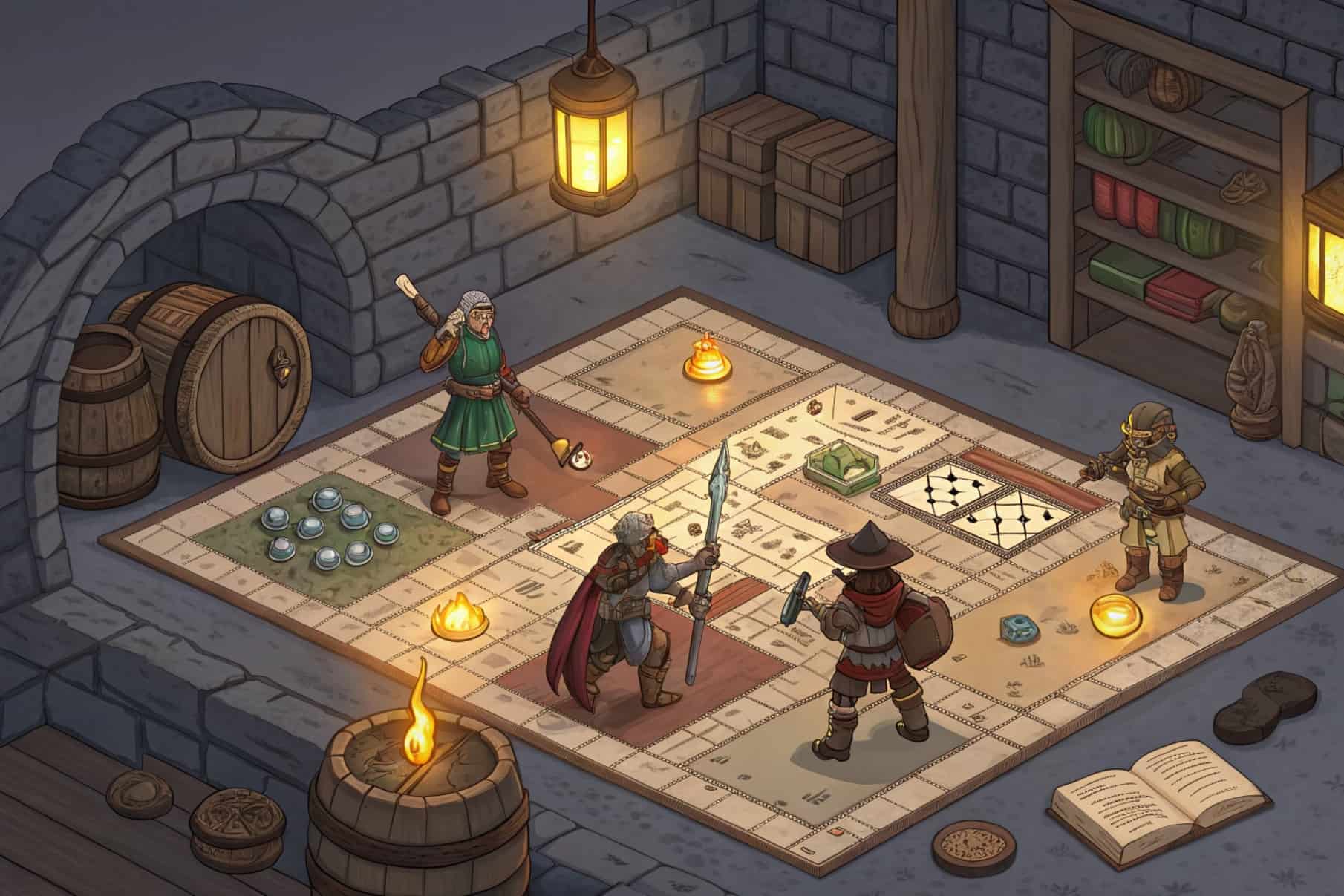Dungeons and Dragons has long been famous as a tabletop role-playing game where players create unique characters and dive into epic fantasy worlds. However, beyond the classic role-playing experience, there is also a growing collection of Dungeons and Dragons board games. These games bring the excitement of D&D into a more structured, accessible, and often quicker gameplay format.
If you are curious about what makes the Dungeons and Dragons board game special, how it differs from traditional D&D, and which versions are worth exploring, this article will walk you through everything you need to know. We’ll break down the basics, explore popular board game editions, and share insights on why these games are attracting both new and longtime fans.
What Is the Dungeons and Dragons Board Game?
First, let’s clarify what the Dungeons and Dragons board game is. Unlike the classic tabletop RPG, where a Dungeon Master (DM) guides a freeform story, the board game versions offer pre-designed scenarios with clear objectives, game boards, cards, miniatures, and dice.
These board games capture the spirit of D&D — such as battling monsters, exploring dungeons, and completing quests — but in a more structured, rule-driven format. This means players don’t need to spend hours learning complicated rules or rely heavily on imagination alone.
Why Choose the Dungeons and Dragons Board Game?
One key benefit of the Dungeons and Dragons board game is accessibility. If you’re new to D&D or tabletop games in general, board games provide a friendly way to start. They typically include simplified rules, quick setups, and cooperative gameplay where everyone works together.
Moreover, these board games allow shorter play sessions than the traditional campaigns. If you want to enjoy the thrill of dungeon crawling and team-based adventures without committing to months-long stories, these board games are perfect.
Key Features of Dungeons and Dragons Board Games:
To better understand these games, here’s a table comparing the main features of the Dungeons and Dragons board game versions with the classic tabletop RPG.
| Feature | Classic D&D RPG | Dungeons and Dragons Board Game |
| Gameplay Style | Open-ended, role-playing, storytelling | Structured, scenario-driven |
| Player Roles | Custom characters, one DM | Pre-made heroes, sometimes rotating DM |
| Setup Requirements | Rulebooks, imagination | Board, cards, miniatures, dice |
| Session Length | Hours to months (campaigns) | 30 minutes to a few hours |
| Player Count | Usually 4-6 players | Usually 1-5 players |
| Replayability | Infinite (custom campaigns) | High (modular boards, varied scenarios) |
| Skill Level | Moderate to advanced | Beginner to intermediate |
| Storytelling Depth | High, player-driven | Moderate, scenario-based |
Popular Dungeons and Dragons Board Games Explained
Over the years, several board games have been released under the D&D brand. Each offers a unique way to experience the world of Dungeons and Dragons without needing extensive role-playing experience.
Dungeons & Dragons – Adventure Begins!
This game is perfect for those new to D&D. It’s a cooperative board game for 2 to 4 players, aimed at players aged 10 and up. You can choose and customize heroes, journey through the city of Neverwinter, fight monsters, and face a final boss.
What makes it special is the rotating Dungeon Master role. Each player takes turns guiding the story, so everyone gets to shape the adventure and experience storytelling from a different angle. This is a great introduction to both the board game and traditional D&D elements.
D&D Adventure System Board Games:
This series of dungeon-crawling board games includes titles like:
- Castle Ravenloft
- Wrath of Ashardalon
- Legend of Drizzt
- Temple of Elemental Evil
- Tomb of Annihilation
- Waterdeep: Dungeon of the Mad Mage
These games are designed for 1 to 5 players and emphasize exploration, combat, and teamwork. The board is modular — built from tiles that reveal new parts of the dungeon as players explore. The encounters are randomized using cards and dice, which adds excitement and replay value.
Each game features unique themes and villains, making every adventure feel fresh. For example, Tomb of Annihilation adds a jungle environment, while Wrath of Ashardalon focuses on battling a fierce red dragon.
How Does the Dungeons and Dragons Board Game Differ from the Classic RPG?
Although both versions share many core ideas, the Dungeons and Dragons board game has several differences that can influence your gaming experience.
Storytelling and Role-Playing:
The traditional D&D RPG relies heavily on storytelling and imagination. The DM creates the world, reacts to players’ choices, and improvises the narrative. This makes each campaign unique and open-ended.
In contrast, the board games use fixed scenarios and objectives. While there is some storytelling, it’s more guided and limited compared to the open-ended RPG. This means less role-playing but more straightforward gameplay.
Complexity and Rules:
Classic D&D can have complex rules requiring time to master. Players often use detailed character sheets and manage many game mechanics.Board games simplify the rules and often use pre-made characters. This makes the game easier to learn and faster to play.
Length and Commitment:
A traditional D&D campaign can span many sessions over months or even years. Board games typically have shorter, self-contained sessions lasting an hour or two. This suits casual play or gaming groups with limited time.
Why Are Dungeons and Dragons Board Games So Popular?
If you are wondering why these board games have gained popularity, there are a few key reasons.
Accessibility for New Players:
Many people find the full D&D system intimidating due to its complexity. The Dungeons and Dragons board game versions provide a gentle introduction, helping players understand core D&D mechanics without overwhelming them.
Cooperative Gameplay:
Most D&D board games focus on cooperative play, which means everyone works together to overcome challenges. This creates a friendly and social atmosphere, perfect for families, friends, or casual gamers.
Replayability and Variety:
Thanks to modular boards, random encounters, and multiple scenarios, these board games offer high replay value. You can enjoy a different adventure each time, keeping the game fresh and exciting.
Miniatures and Visual Appeal:
The inclusion of detailed miniatures and well-designed boards adds a tactile and visual dimension to the game. This draws in players who enjoy the physical aspect of board gaming.
Tips for Getting Started with a Dungeons and Dragons Board Game:
If you’re new to the world of D&D board games, here are some helpful tips:
- Choose the Right Game: Start with beginner-friendly titles like Adventure Begins before moving to more complex dungeon crawlers.
- Play Cooperatively: Work together with friends and family to enjoy the game’s full potential.
- Read the Rules First: Spend time understanding the setup and game mechanics to avoid confusion during play.
- Use Online Resources: There are many tutorials, videos, and forums that can help new players.
- Be Patient: Like any game, it takes a few sessions to get comfortable with the flow and strategies.
Common Components Found in Dungeons and Dragons Board Games:
To help you recognize and understand the parts of these board games, here’s a simple breakdown of common components:
| Component | Description | Purpose |
| Miniatures | Small detailed figures representing heroes and monsters | Visual representation on the board |
| Modular Board | Tiles or pieces that create a changing map | Allows dynamic dungeon layouts |
| Cards | Encounter, treasure, and event cards | Adds randomness and story elements |
| Dice | Usually include a 20-sided die and other dice | Determines outcomes and actions |
| Character Sheets | Pre-made or customizable hero profiles | Track health, abilities, and items |
| Tokens | Markers used for traps, spells, or conditions | Help manage game status |
Exploring the Fantasy Worlds Within Dungeons and Dragons Board Games:
One exciting aspect of these games is how they introduce players to the rich lore and settings of D&D. You can explore famous locations like Neverwinter, battle iconic monsters such as Beholders and Dragons, and meet legendary characters.
Each game provides a unique atmosphere and theme, ranging from dark dungeons and haunted castles to mystical jungles and ancient temples. This variety makes every game session feel like stepping into a new story.
The Role of Strategy and Teamwork in Dungeons and Dragons Board Games:
Unlike the traditional RPG’s emphasis on role-playing and storytelling, the board game versions focus more on strategy and team coordination.
Players must plan their moves carefully, use their heroes’ strengths wisely, and cooperate to defeat powerful enemies. Success often depends on good communication and shared tactics, making teamwork a key to victory.
FAQS:
1. What makes the Dungeons and Dragons board game different from the traditional tabletop RPG?
The Dungeons and Dragons board game offers a more structured and easy-to-learn experience with pre-made characters and set scenarios, unlike the traditional RPG, which relies heavily on freeform storytelling and a Dungeon Master’s creativity.
2. Can beginners enjoy playing Dungeons and Dragons board games?
Yes, many Dungeons and Dragons board games are designed for beginners with simple rules and cooperative play, making them perfect for players new to tabletop role-playing or fantasy board games.
3. How many players can join a typical Dungeons and Dragons board game session?
Most Dungeons and Dragons board games support between 1 to 5 players, allowing for solo play or small groups, which makes them flexible for different gaming situations.
4. Are miniatures and dice important components in Dungeons and Dragons board games?
Yes, miniatures help visualize heroes and monsters on the modular game board, while dice rolls determine actions and combat results, both adding to the immersive gameplay experience.
5. Where can I find and purchase official Dungeons and Dragons board games?
Official Dungeons and Dragons board games can be found at hobby stores, major online retailers like Amazon, and specialty game shops that carry fantasy board games and role-playing game accessories.
Conclusion:
In summary, the Dungeons and Dragons board game offers a fantastic alternative to the classic RPG experience. It’s more accessible, quicker to play, and still packed with fun, adventure, and fantasy elements. Whether you’re a longtime D&D fan or new to tabletop games, these board games can provide engaging adventures without the steep learning curve.
If you want to explore rich fantasy worlds in a structured setting, enjoy cooperative play, and like the thrill of dungeon crawling, then trying out a Dungeons and Dragons board game might be your next great adventure.
Related post:












